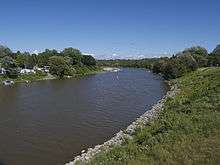Saugeen River

The Saugeen River is located in southern Ontario, Canada, flowing generally north-west about 160 kilometres (99 mi) before exiting into Lake Huron. The river is navigable for some distance, and was once an important barge route. Today the river is best known for its fishing and as a canoe route.
The river's name comes from an Ojibwa language word Zaagiing, meaning outlet.
Tributaries
The river is split in two for most of its length, with the South and North Saugeens both being formed from a number of smaller branches starting south-west of Owen Sound. The two main branches meet about 24 kilometres (15 mi) south-southeast of its exit into Lake Huron, at Southampton.
- Rocky Saugeen
- Camp Creek
- Styx River
- Beatty Saugeen River
- Teeswater River
Communities
Hungerford's crawling water beetle
The North Saugeen River is home to one of the most critically endangered of all insects: the Hungerford's crawling water beetle. In fact, the only known population of Hungerford's crawling water beetles outside of the United States were discovered near Scone in Bruce County, Ontario. In 1986, 42 beetles were identified at a site downstream from a dam there. An unspecified number of beetles were last recorded in 2001, but surveys in 2002 uncovered no specimens. As a result, the status of this population of Hungerford's crawling water beetles is uncertain at present.
Although the Hungerford's crawling water beetle was categorized as endangered on March 7, 1994, under the provisions of the U.S. Endangered Species Act, it is currently not protected in Canada.
See also
External links
| Wikimedia Commons has media related to Saugeen River. |
Coordinates: 44°13′11″N 81°10′42″W / 44.21961°N 81.17832°W